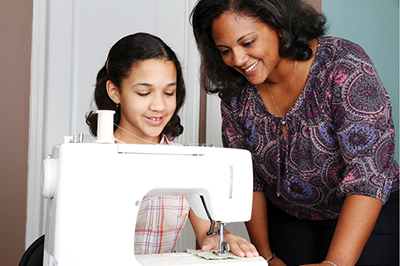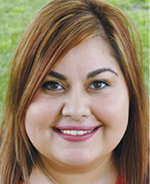Buying a Sewing Machine
Guide C-203
Revised by Jennah McKinley
College of Agricultural, Consumer and Environmental Sciences
Author: Extension Family and Consumer Sciences Agent, Eddy County Extension Office, New Mexico State University. (Print Friendly PDF)
Which is the best sewing machine for you? That all depends on your skill level and budget. Before buying a sewing machine, you should assess your needs and skills. A few hundred dollars buys a good, basic sewing machine that can handle most clothing and crafts or quilting projects. Spending even more gets you additional automated functions, while a top-of-the-line machine can cost thousands of dollars. The best part? It will produce professional-quality designs and you don’t even need to know how to sew.

© Rmarmion | Dreamstime
When it’s time to buy a sewing machine, buyers can be nearly overwhelmed by all the decisions: straight stitch or zigzag stitch, stretch and fancy stitches, portable or cabinet model machine, regular duty or heavy duty, open arm or flat bed, mechanical or electronic, expensive or inexpensive, new or used?
The information in this guide is meant to help make shopping for a sewing machine easier.
Where to Begin
Use this checklist as a guide when considering the factors that should influence the kind of sewing machine you buy:
What kind of sewing do you plan to do?
- Make clothes for yourself
- Sew for a growing family
- Mending only
- Decorative sewing
Where will you use the sewing machine?
- In a sewing room
- In the family room
- On a dining table
Where will the machine be stored?
- In what room
- In a cabinet, and what style
- In a closet (if the machine is portable)
- Does the machine come with a storage case, and is that an extra cost?
How long do you intend to use the machine?
- A few months
- A few years
- Until something new comes out
- All your sewing lifetime
Before You Buy
Choose your retailer wisely. Different retail channels offer different advantages. An independent shop might not have the lowest prices, but it will usually offers lessons and more personalized service, and repairs can often be done in the store—sometimes even on the spot. Note that some models are only sold at authorized dealers, and they offer instructional classes and repairs.
As you consider buying a sewing machine, try to complete each of the following steps on the way to a final choice. Check each item off when it is finished.
- Check out currently available sewing machines. Go to a library or look online and read articles on how to buy a sewing machine. Study the articles that compare machine types and brands to determine which are recommended by consumer research services.
- Comparison shop at reliable local dealers. Don’t be afraid to ask questions. Check several brands before making the final decision.
- Check all the models. Don’t be pushed into buying more machine than you need. The top-of-the-line isn’t always the best buy for the money.
- Discuss sewing machines with friends. Which ones have they had good and bad experiences with?
- As you shop, try out each machine that interests you. Try it on all the kinds of fabrics you usually sew. Try all the fancy stitch settings; try the stitch length regulator and backstitch setting. Adjust the tension and presser foot.
- Be sure you know exactly what you are getting for the sale price—accessories, guarantee, cabinet or case?
- Be sure you understand all financial obligations involved in buying the machine before making the final decision.
Types of Machines
Consider the types of sewing machines available while shopping. Check for the type that best meets your needs.
Straight-stitch Machines
If you’re an occasional sewer or on a budget, this type should work just fine. They require you to manipulate most controls by hand and can handle basic repairs, hems, simple clothing, and crafts projects. This type of machine is usually the least expensive. It sews forward and backward, and is suitable for mending and routine sewing. It’s probably the most practical machine for someone who will sew only a little, or does not intend to use decorative stitching.
Mechanical Machines
This type has all the functions of a straight-stitch machine, plus the ability to do zigzag and stretch stitching, make buttonholes, finish seam edges, sew stretchy fabrics, and, in some cases, blind hem and stretch stitch. Some machines have built-in decorative stitches that are usually selected with hand controls or cams that can be inserted for the desired stitch, or a combination of the two. The combination model is the most versatile. This machine is a good choice for the home sewer who uses decorative stitches often; however, using this type of machine to its full potential requires a thorough knowledge of the machine and some practice.
Electronic or Computerized Machine
If you sew frequently or can spend more, an electronic model can be a worthwhile investment. These shift many tedious sewing jobs from your hands to computer chips. A typical machine offers touchpad controls, an LED screen, an array of presser feet for challenges such as piping and topstitching, and settings for dozens or even hundreds of stitch types. This type has the capabilities of the mechanical zigzag type, and much more. It is controlled by electronic chips, like those found in computers, rather than mechanical parts. The electronic system allows stitches to be selected by pushing a button. Optimal stitch widths, stitch lengths, and density are programmed into the machine by the manufacturer, but can be adjusted by the user. The best use of this machine depends on a thorough knowledge of the machine and how it is used.
Embroidery/Sewing Machines
In addition to all of the features and options found in an elaborate electronic machine, you’ll also have the ability to do monogramming and embroidery for projects such as garments, bedspreads, and pillowcases. The machine holds a hoop under its needles and moves the hoop in all four directions as the needle sews. You start by stretching fabric over a hoop. Then, secure the hoop under the needle. Designs are built into the machine’s memory, or purchased on memory cards, CDs, or data sticks or downloaded from your computer. A touchscreen or computer link lets you position the design and specify colors for design elements. Often machines let you resize, reposition, and mirror designs, and will sound an alert to let you know when to change colors.
Consider the Cost
When all the comparisons and testing are done and it’s time to buy the sewing machine, carefully weigh the cost factor. Be sure your planned use of special stitches and other fancy features of the machine warrants the expense involved in the initial purchase of the machine. Also, be sure you want to—or have the time to—learn all the skills needed to make full use of the machine’s features. Then consider how long you will use the machine. The useful life of a good machine can be 20 years or more. If you intend to use the machine for a long time, you may want to invest more money than if you intend to keep the machine for a short time. Be sure to buy the machine that best suits your needs for the amount of money you have to spend.
There are sales and special offers that can save buyers quite a bit of money. However, be wary of special service contracts, special discounts, and offers received in the mail or by telephone. These offers often involve another transaction that is as expensive or more expensive than buying a similar machine from a reliable local dealer.
Ask About the Warranty
What does it cover, and what does it exclude? Look for sales and try before you buy. Bring fabric samples and test several machines on a variety of fabrics and settings to make sure that they stitch evenly and are easy to use.
Check Repair Polices
Many dealers offer in-store service. If not, they’ll direct you to a repair center or to the manufacturer. No matter who does the repairs, ask about turnaround time, which can vary from days to weeks. Remember that repairs made by technicians who are not factory-authorized can void the manufacturer’s warranty. And keep your machine’s box and packaging in case it needs to be shipped for repairs.
Ways to Save
Search online for coupons and ask about upcoming sales and trade-in allowances. Don’t be shy about negotiating with dealers and asking for free sewing lessons.
What About a Used Machine?
Don’t eliminate the possibility of buying a good, used sewing machine. In addition to all the things to consider with a new machine, consider the following:
- Has the machine been well cared for?
- There are few, if any, scratches or dents.
- It does not show signs of rough use.
- There are no missing parts.
- Accessories are included (bobbins, zipper foot).
How does it operate?
- Foot control or knee lever is easy to operate.
- Belts are in good condition and correctly
adjusted.
- Wiring is in good condition.
- The machine runs smoothly and without excessive vibration and noise.
Other Things to Consider
Once the important decision is made to buy a particular sewing machine—new or used—there are other things to consider along with the machine itself:
- Is there an instruction manual with the machine?
- Are accessories and extra parts included or can they be bought easily (needles, bobbins, zipper foot, ruffler)?
- Are there lessons available on how to use the machine; free or for a fee?
- Does the dealer have a reputation for satisfied customers?
- Is there a guarantee or warranty? What does it cover and for how long? Who is responsible for living up to the guarantee, the dealer or the manufacturer?
- Is local service available?
For further reading
C-102: Sewing Machine Maintenance
https://pubs.nmsu.edu/_c/C102/
C-202: Checklist of Common Sewing Machine Problems
https://pubs.nmsu.edu/_c/C202/
C-213: Free-Motion Machine Embroidery
https://pubs.nmsu.edu/_c/C213/
C-228: Pattern Alteration
https://pubs.nmsu.edu/_c/C228/

Jennah McKinley is a Family and Consumer Sciences Agent and I-CAN Supervisor for NMSU’s Cooperative Extension Service Office in Eddy County. She earned her B.S. in family and consumer sciences education and her M.Ed. in online teaching and learning from NMSU. She specializes in community education and 4-H youth development. Her programs focus on parenting, childcare, nutrition, diabetes education, family resource management, and youth development.
To find more resources for your business, home, or family, visit the College of Agricultural, Consumer and Environmental Sciences on the World Wide Web at pubs.nmsu.edu
Contents of publications may be freely reproduced for educational purposes. All other rights reserved. For permission to use publications for other purposes, contact pubs@nmsu.edu or the authors listed on the publication.
New Mexico State University is an equal opportunity/affirmative action employer and educator. NMSU and the U.S. Department of Agriculture cooperating.
Revised December 2017 Las Cruces, NM


